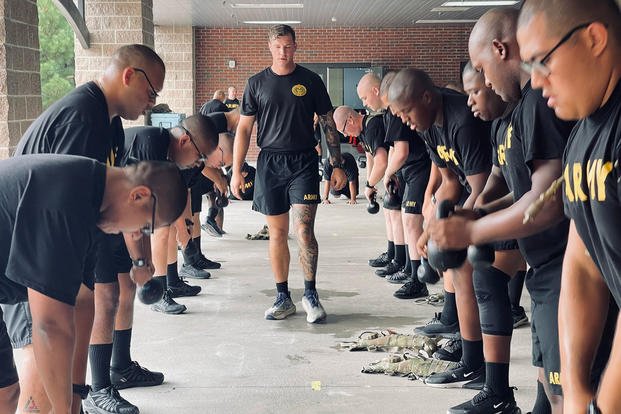Steve Beynon

The Army's pre-basic training courses are here to stay and will likely be a fundamental tool for the service to fill the ranks amid falling academic performance and growing obesity among young Americans.
The Future Soldier Preparatory Course was launched as a pilot program in August last year, with most of it held here at Fort Jackson. Early results suggest it could be a massive success -- winning virtually universal praise from Army officials -- as it helps the service climb out of the biggest recruiting slump in decades.
Starting in October, the course will move from that pilot stage into a permanent school in the Army's portfolio, opening up more resources and funding, and signaling the preparatory courses will likely be an integral part of the service for the foreseeable future.
"Our insistence on not lowering the standard to enter basic training means that we have to be ready to remove obstacles for those that want to serve," Brig. Gen. Jason Kelly, commander of the Army Training Center and Fort Jackson, told Military.com in an interview. "So, this is a program of record. Next month, that will be true. We're moving away from pilot."
As of Tuesday, 10,260 soldiers had attended at least one of the prep courses and moved on to basic training -- a 95% graduation rate, according to data provided by the service.
Those are soldiers who otherwise would not have been eligible to enlist at all before the new program, making up much of the Army's recruiting deficit. The service came up 15,000 soldiers short of its 60,000 recruiting goal last year.
The drop-off in recruiting is among the service's top concerns and is due to an amalgamation of issues. But at the top of those problems is a shrinking pool of eligible applicants, with Army officials estimating that only about 23% of 17- to 24-year-olds are qualified to serve.
Childhood obesity has ballooned in recent decades, rising from 5% in the 1970s to 22% among 12- to 19-year-olds today, according to data from the Centers for Disease Control and Prevention. Experts have long labeled the runaway obesity epidemic in the U.S. a major national security problem -- one that only gets worse with each passing year.
Meanwhile, academic performance in schools has fallen in the past decade. ACT scores, which are used in college admissions, have steadily declined since the early 2010s, while the COVID-19 pandemic accelerated a major dip in high school reading and math abilities.
The Army prep courses provide lower-performing applicants a pathway into the service. Those who attend the pre-basic training courses could not initially meet the standard, either by performing poorly on the Armed Services Vocational Aptitude Battery, or ASVAB, or being too overweight to serve.
Under the new courses, recruits have 90 days to come into compliance with the Army standard and then can ship off to basic training. If they don't, they go home and are removed from the Army.
"When I came into the Army, I'd never shot a rifle. I grew up an inner-city kid. I was taught how to shoot when I joined," Kelly said. "That's how I think about what we're doing here."
Despite the widespread optimism over the program, Army Secretary Christine Wormuth has tamped down expectations.
Wormuth said the service still expects to miss its recruiting goal of 65,000 new active-duty soldiers this year. While the active force forecasts falling short, the Army National Guard has made significant headway in recruiting this year, according to internal data reviewed by Military.com.
The pre-basic courses are separated into two tracks, academic and fitness. Previously, recruits could do only one of those courses. But in June, the Army started allowing recruits to do both. So far, 58 soldiers have completed both tracks, and there are a total of 108 currently enrolled in the overall program.
Those who need help meeting both Army academic and fitness standards typically do the academic course first, in hopes of losing enough weight during daily physical training to avoid having to go through the fitness course.
The soldiers retake the ASVAB every three weeks, and pick their military occupation with potential entitlement to enlistment bonuses, which have spiked to $50,000 for some roles, including infantry. Most recruits perform well enough on the ASVAB to progress into basic training after the first few weeks but can stay in the program as long as 90 days.
In some cases, they can pick their duty station, but those options are limited.
On average, the soldiers boost their entrance exam score by 19 points, a shift from being sub-standard to qualifying for a huge swath of jobs in the service.
In the fitness track, applicants can enlist with up to 6% more body fat than the Army allows. For men, the standard ranges between 20% and 26% body fat depending on age. For women, it's 30% to 36%. Recruits can move on to basic training being 2% above the normal Army standard, with the presumption they'll lose that weight there.
Recruits have their body fat measured once a week. On average, they lose 1.5% body fat each week at the prep course.
"Some have never learned how to make good food choices, and don't understand how to have a healthy plate. We're doing it here," Kelly said. "Same thing on the academic side. Regardless of what you were doing in the classroom back home, we're providing focus, training and investment, so that you can become all you can be."
No comments:
Post a Comment